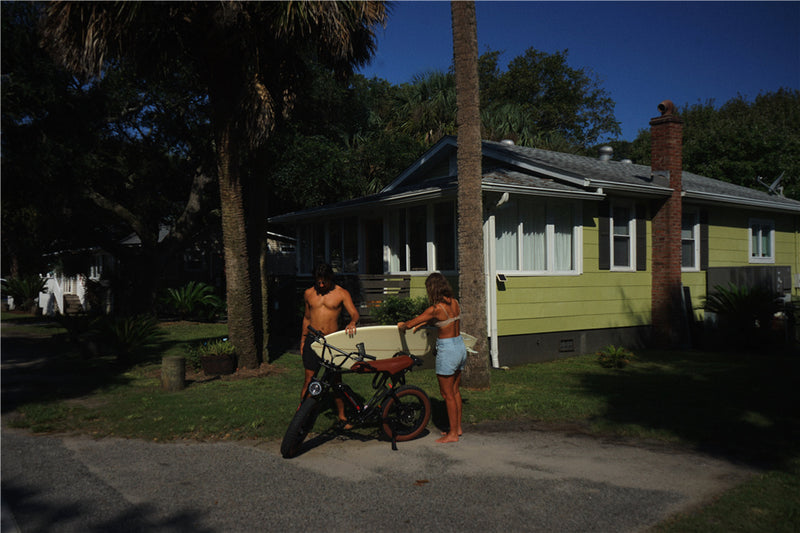Feeling frustrated because your ebike isn't as zippy as it used to be? Understanding why your electric bike slows down starts with one fundamental principle: Power = Current × Voltage (P = I × V). Let's break down exactly what this means for your rides and how to fix speed issues.
The Core Science Behind E-Bike Speed
Think of your e-bike's electrical system like a water reservoir feeding a turbine:
- Voltage is like water pressure (height of water)
- Current is like water flow rate
- Power is the total energy available to move your bike
Why Your E-Bike Loses Power
As your battery depletes, two critical things happen:
- Battery voltage drops (like decreasing water pressure)
- Maximum current output decreases (like reduced flow capacity)
Since Power (P) = Current (I) × Voltage (V), when both voltage and current capability drop, your available power drops significantly. This is why your bike feels slower when the battery gets low.
Typical Voltage Patterns:
- Full battery: 42V
- 75% charge: ~39V
- 50% charge: ~36V
- 25% charge: ~34V
- Near empty: Below 32V
When voltage drops below 32V, most controllers reduce power output to protect the battery, making your bike feel sluggish.
Real-World Impact on Your Ride
This power reduction shows up in several ways:
- Reduced top speed
- Less assistance on hills
- Slower acceleration
- More effort needed to maintain speed
Battery Health and Performance
A new battery maintains higher voltage levels longer. As batteries age:
- Voltage drops more quickly under load
- Maximum current output decreases
- Capacity (range) reduces
- Recovery time between high-power demands increases
Think of an old battery like a leaky water tank - it can't maintain pressure (voltage) or flow (current) as well as it used to.
Common Causes of Power Loss
- Natural Battery Discharge
- Most noticeable above 15 mph
- Particularly evident on hills
- Normal and expected
- Battery Age
- Capacity loss of 20-30% after 500 cycles
- Reduced peak power output
- Lower voltage under load
- Temperature Effects
- Cold reduces chemical reaction speed
- Voltage and current output decrease
- Temporary power loss until warmed up
- Motor Efficiency
- Wear reduces power conversion efficiency
- Magnets can weaken over time
- Bearings affect power transfer
Read more: Understanding the Role and Function of an E-bike Controller
Solutions and Maintenance
Immediate Fixes
- Keep battery above 25% charge
- Monitor voltage under load
- Use appropriate assist levels
- Maintain optimal tire pressure
Long-term Care
- Regular charging habits
- Charge after each long ride
- Avoid complete discharge
- Store at 40-70% charge
- Temperature management
- Avoid extreme heat/cold
- Store in moderate temperatures
- Allow warm-up time in cold weather
- Regular maintenance
- Clean connections
- Check motor bearings
- Monitor battery health
Professional Diagnosis
When to seek help:
- Sudden power loss
- Unusual voltage behavior
- Battery not holding charge
- Reduced range over 40%
What professionals check:
- Individual cell voltages
- Controller output
- Motor phase balance
- System efficiency
Preventive Measures
Keep your e-bike performing at its best:
- Track battery performance
- Monitor voltage patterns
- Document range changes
- Regular system checks
Quick System Check Guide
Before each ride, verify:
- Battery charge level
- Voltage reading
- Motor operation
- Controller response
- Normal system sounds
Understanding Battery Life
Typical battery lifespan:
- 500-800 charge cycles
- 3-5 years regular use
- 20-30% capacity loss normal
- Performance decline gradual
The Bottom Line
Your e-bike's speed is directly tied to its power output (P = I × V). As your battery depletes or ages, both current and voltage capabilities decrease, resulting in reduced power and speed. Understanding this helps you:
- Anticipate performance changes
- Plan rides better
- Maintain your battery properly
- Know when to seek service
Remember: Some power loss is normal over time, but proper maintenance and understanding your system helps maximize performance and longevity.
Happy riding, and may your watts stay strong!
FAQs
Why does my e-bike slow down when the battery is low?
As the battery depletes, voltage and current drop, reducing the power available, which slows down your e-bike.
How can I prevent power loss in my e-bike?
Keep the battery above 25% charge, monitor voltage, and maintain proper tire pressure for optimal performance.
When should I seek professional help for my e-bike?
Seek help if there’s sudden power loss, unusual voltage behavior, or if the battery won’t hold a charge.


















